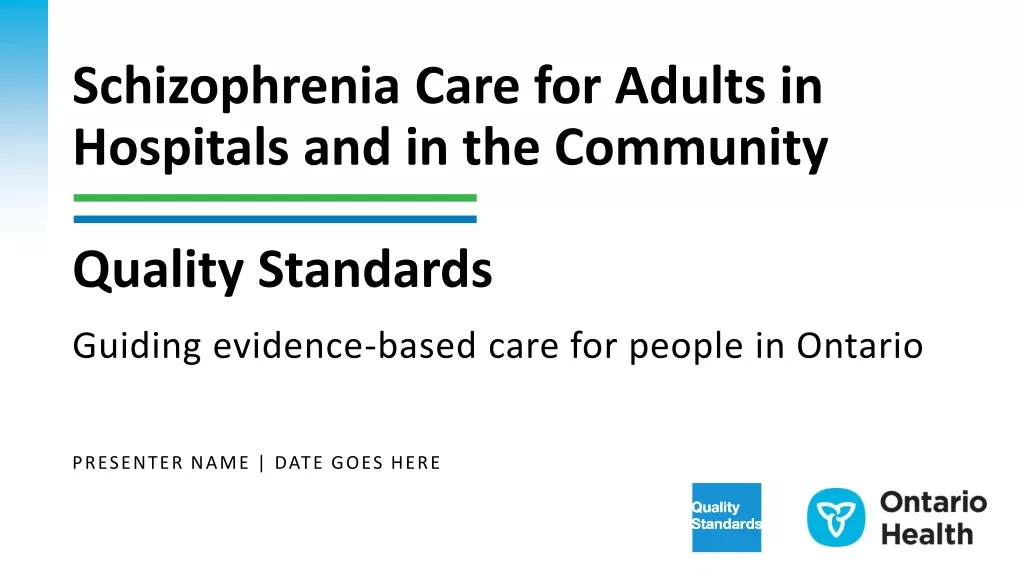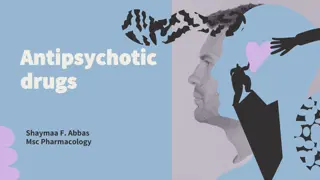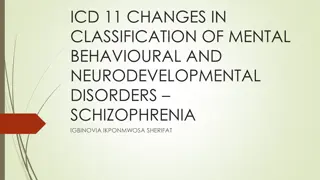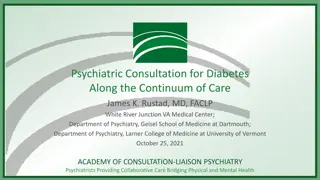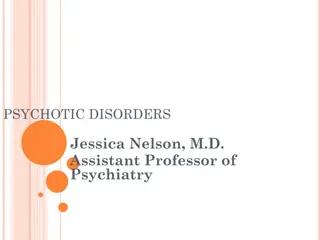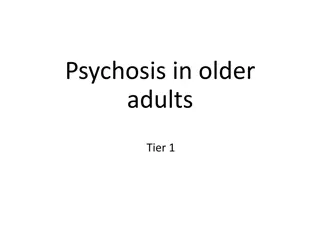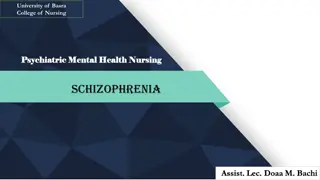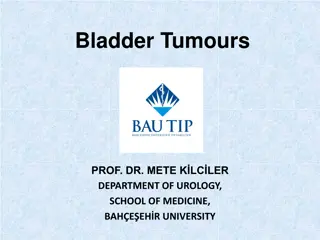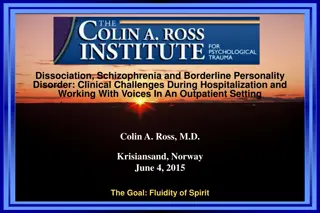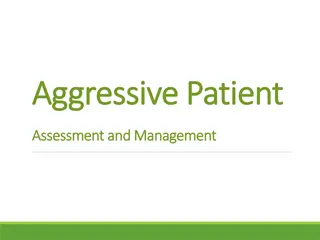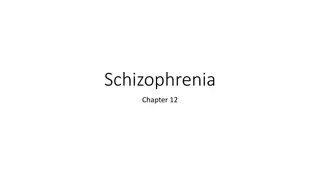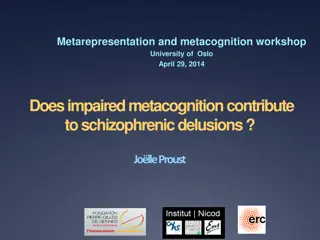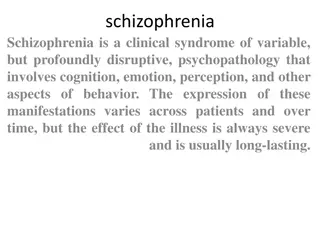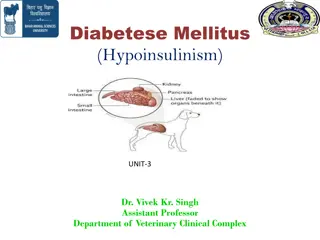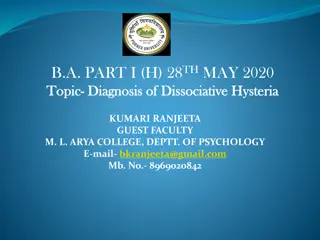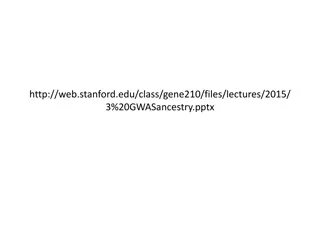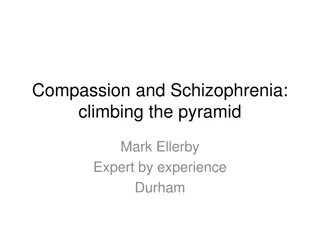Schizophrenia: Symptoms, Diagnosis, and Etiology
Schizophrenia is a chronic psychotic syndrome affecting 1% of the population, with onset in late teens to early twenties. It includes positive symptoms like hallucinations and delusions, negative symptoms such as apathy, and cognitive impairments. The DSM-V outlines criteria for diagnosis, requiring presence of specific symptoms. Etiology involves genetic factors, with high heritability and involvement of multiple genes, as well as environmental stressors like maternal stress and substance abuse.
Download Presentation

Please find below an Image/Link to download the presentation.
The content on the website is provided AS IS for your information and personal use only. It may not be sold, licensed, or shared on other websites without obtaining consent from the author.If you encounter any issues during the download, it is possible that the publisher has removed the file from their server.
You are allowed to download the files provided on this website for personal or commercial use, subject to the condition that they are used lawfully. All files are the property of their respective owners.
The content on the website is provided AS IS for your information and personal use only. It may not be sold, licensed, or shared on other websites without obtaining consent from the author.
E N D
Presentation Transcript
Schizophrenia Schizophrenia is a chronic remitting and relapsing or progressive psychotic syndrome affects 1% of the population in all races and culture associated with significant impairment in social interactions and occupational functioning the onset of schizophrenia is in the late teens - early twenties and an average reduction of lifespan of 15 to 25 years
Positive Symptoms disturbance of reality perception Hallucinations (false perceptions: hearing voices others do not hear; Seeing, feeling, or smelling things other do not) Delusions (false beliefs: Intense suspicion; Thoughts controlled by Martians; Radios implanted in teeth) Disorganized Speech and behavior (Loose associations, Word salad, Flight of Ideas) Negative Symptoms inappropriate or diminished affect (mood) Apathy, social withdrawal, anhedonia, emotional blunting, extreme inattentiveness or lack of motivation to interact with the environment (Negative symptoms are progressive and less responsive to therapy) Cognitive impairment Cognitive deficits and deficits in attention and executive function
Diagnostic and Statistical Manual of Mental Disorders (DSM-V):criteria for Schizophrenia At least two of the following symptoms for a clinically significant portion of time during 1-month period must be present, one of them being the 1, 2 or 3 item: 1. Delusions 2. Hallucinations 3. Disorganized speech 4. Disorganized or catatonic behavior 5. Negative symptoms
Etiology of Schizophrenia 1. Heritability and Genetic Factors Genetic predisposition with multiple genes involved, estimated to explain 80% of the risk Gene-expression profiling studies implicate pathway associated with the immune system, cytoskeleton development and synaptic plasticity 2. Environmental stressors Maternal stress, maternal infections Birth complications Nutritional deficiency; Autoimmune diseases; Head injury; Childhood adversity Substance of abuse
1. Genetic Factors Schizophrenia is highly polygenic and the genetic risk is highly pleiotropic Some genes implicated: GRIN2A (subunit of the NMDA receptor) GRIA1 (subunit of the AMPA receptor) CACNA1C (encoding VDCCs) PSD95, CACNG2 (proteins associated with the post- synaptic scaffold kinases) SRR (serine racemase)
Neurodevelopmental abnormalities During early brain development, environmental stressors can alter the normal program of brain maturation (progenitor cells proliferation, neuronal migration, dendritic arborization and outgrowth)
Neuronal anatomic abnormalities Person with schizophrenia have lower gray-matter volumes (magnetic resonance imaging) and fewer dendrites and dendritic spines (postmortem studies) During the prodromal phase of psychosis, there is a greater rate of gray-matter loss over time in the prefrontal and parahippocampal regions than among persons in whom psychosis does not develop The rate of gray-matter loss has been associated with elevated levels of immunologic markers that participate in activation of brain microglia, suggesting a role for cytokines in the disease
Hypofrontality: reduced frontal lobe activity Functional imaging techniques (fPET) reveal decreased metabolic activity in frontal cortex of schizophrenics
Dopamine Receptors family D1 ++ D5 D2 ++ D3-4 Striatum Prefrontal Cortex ++ + Limbic system ++ + ++ + Hypothalamus Pituitary gland ++ ++
Dopamine System Four major pathways for the dopaminergic system in the brain: I. II. III. The Mesocortical Pathway IV. The Tuberoinfundibular Pathway The Nigro-Striatal Pathway The Mesolimbic Pathway Chemoreceptor trigger zone (Emesis)
I. The Nigrostriatal Pathway Projects from the substantia nigra to the basal ganglia Substantia nigra Striatum A part of the extrapyramidal system, is involved in the control of motility Reduced activity results in rigidity, tremor and difficulty initiating movement (bradykinesia) Parkinsonism
II. The Mesolimbic Pathway Projects from the VTA to limbic system via Nucleus Accumbens, amygdala and hippocampus Ventral tegmental area Nucleus accumbens Involved in modulating behavioral responses to stimuli that activate feelings of reward (motivation) and reinforcement Over-activity may produce the positive symptoms of schizophrenia (delusions and hallucinations)
III. The Mesocortical Pathway Frontal cortex Projects from the VTA to frontal cortex Involved in motivation and emotional responses Ventral tegmental area Can be associated with both positive and negative symptoms (mood) Blockade may help reduce negative symptoms of schizophrenia
IV. The tubero-infundibular pathway Projects from hypothalamus to median eminence and pituitary gland Involved in control of prolactine release (suppressed by dopamine) hypothalamus Pituitary Blockade of this pathway produces galactorrhea
Dopamine Theory of Schizophrenia Schizophrenia could be caused by an aberrant, increased activity of the dopaminergic system Drugs that increase DA in the limbic system cause psychosis: L-DOPA (dopamine precursor) can produce hallucinations Apomorphine and bromocriptine (D2 receptor agonists) produce behavioral abnormalities in animals (stereotyped behavior) Amphetamine and cocaine produce a psychotic behavior similar to the positive features of schizophrenia Drugs that reduce DA activity in the limbic system (postsynaptic D2 receptor antagonists) reduce psychosis and are effective in controlling the positive symptoms Many antipsychotics block the D2 receptor
Criticisms of the DA hypothesis Normal levels of DA metabolites are present in CSF of many schizophrenics D2 receptor antagonists are only partially effective in most (70%) patients and ineffective for some Delayed onset of therapeutic effects, not consistent with only an antagonism toward D2 receptors (slow developing compensatory change/adaptation?) Atypical antipsychotics have low affinity for D2 receptors Furthermore..... Drugs like Phencyclidine (CPC) and ketamine (NMDA receptor blockers) or LSD (5-HT partial agonist) cause psychotic behavior
NMDA receptor hypofunction hypothesis NMDA receptor hypofunction causes excessive glutamate release which triggers neuronal injury throughout corticolimbic regions Disruption of corticolimbic glutamatergic transmission by acute PCP leads to intense and disorganized hyperactivity (model for positive symptoms) Disruption of corticolimbic glutamatergic transmission by chronic PCP leads to deficits in long-term memory, attention and social interaction (model for cognitive impairment and negative symptoms) PCP produces hypofrontality in nonhuman primates, and this effect is reversed by antipsychotic drugs
The role of Serotonin (5-HT) 5-HT has a modulatory effect on dopaminergic neurones LSD, a partial 5-HT receptor agonist, produces hallucinations and behavioral disturbance M-chlorophenylpiperazine (M-CPP), a 5-HT receptor agonist, worsens psychotic symptoms Ritanserin, a 5-HT receptor antagonists, attenuates psychotic symptoms Dopamine Acetylcholine Glutamate GABA Neuropeptides Serotonin
1. Clinical potency of typical antipsychotic drugs correlated with their affinity for D2 receptors
Antagonism of dopamine D2 receptors is the basis for both the efficacy and side effects of typical antipsychotics EFFICACY: D2 Receptor antagonism in the Mesolimbic pathway decreases positive symptoms SIDE EFFECTS: D2 Receptor antagonism in the Mesocortical pathway can increase negative symptoms in the Nigro-Striatal pathway causes Extra-Pyramidal Syndrome (EPS) or Parkinsonism, Dystonia, Tardive dyskinesia, Akathisia, Neuroleptic malignant syndrome in the pituitary gland causes endocrine changes (hyperprolactinemia, amenorrhea, galactorrhea, infertility, gynecomastia and sexual dysfunction)
Typical antipsychotic are also effective antagonists at ACh, 5-HT and NE receptors Muscarinic receptor blockade Blurred vision, Dry mouth, Sinus tachycardia, Constipation, Urinary retention, Memory dysfunction Histamine H1 Blockade Sedation, drowsiness, Weight gain, Hypotension Alpha-1 receptor blockade Arteriolar dilation reduction of arterial blood pressure and Dizziness Venodilation orthostatic hypotension - Reflex tachycardia
Typical Antipsychotic drugs All are equally effective but differ in their tolerability All show a significant delay before they become effective All produce significant adverse effects (EPS occurs at clinically effective doses) Limited efficacy against negative symptoms A substantial portion of patients (25% to 40%) respond poorly to treatment Drug interaction with additive effects with sedatives, anticholinergic, antihistaminergics, alfa receptor blocking agents Efficacious for positive symptoms Low-cost
First generation TYPICAL Second generation ATYPICAL 1952 1960s 1980s 1990s 2000s Haloperidol (Serenase) Fluphenazine Thioridazine Trifluoperazine Aripiprazole Paliperidone Iloperidone Asenapine Lurasidone Risperidone Olanzapine Quetiapine Ziprasidone Chlor promazine Clozapine Have minimal Parkinsonian side effects Have Parkinsonian side effects Effective against positive symptoms Effective against both positive and negative symptoms Not all patients respond to drug therapy Effective in "resistant" patients
Atypical antipsychotic drugs Are effective against positive and negative symptoms with some improvement in cognition Are effective in patients refractory to typical neuroleptics Greatly reduced or absent EPS Disadvantage: Expensive
Antipsychotics: receptor order of potency TYPICAL Chlorpromazine 1 = 5-HT2 = D2 > D1 > M > 2 Haloperidol D2 > D1 = D4 > 1 > 5-HT2 >H1>M = 2 Clozapine D4 = 1 > 5-HT2 = M > D2 = D1 = 2 ;H1 ATYPICAL Quetiapine 5-HT2 = D2 = 1 = 2 ; H1 Risperidone 5-HT2 >> 1 > H1 > D2 > 2 >> D1 Sertindole 5-HT2 > D2 = 1
D2 5-HT2 D2 5-HT2 TYPICAL ATYPICAL
D1 D2 5-HT2A 5-HT1A 5-HT6 5-HT7 alfa 2 alfa 1 H1 M
Atypical Antipsychotics: Drug/Receptor Characteristics All atypical neuroleptics have affinities for D1, D3, D4, histamine, and -AR receptors and display balanced D2/D1 and 5-HT2 receptors antagonism Due to the modulatory role of 5-HT on dopaminergic neurons, atypical antipsychotic drugs with 5-HT receptors affinity contributes to: the antipsychotic action (Blockade of 5-HT2A receptors in the mesocortical pathway enhances the release of both dopamine and glutamate) the low risk of producing EPS (Blockade of 5-HT2A receptors in the nigro-striatal pathway enhances dopamine release) the ability to improve cognition (5-HT6 and 7 antagonists exert pro-cognitive effect
SIDE EFFECTS NOTE NEGATIVE SYMPTOMS POSITIVE SYMPTOMS Sedation, hypotension, diabete Seizure + +/- CLOZAPINE Agranulocytosis Elevated prolactin levels, EPS + +/- RISPERIDONE + +/- Diabetes OLANZAPINE Weight gain ZIPRASIDONE +/- + Uncontrolled movements Sedation QUIETAPINE +/- + Also for depression - +/- Uncontrolled movements ARIPRIPAZOLE
Modulation of neurotrophic factors by antipsychotic drugs Expression of Brain-Derived Neurotrophic Factor (BDNF) and its high affinity receptor TrkB are reduced in the brain of schizophrenic patients Neurotrophin (NTF) levels are reduced in the serum of schizophrenic patients Antipsychotic drugs may be able to normalize levels of NTF or modulate their expression in order to enhance and promote neuronal plasticity


